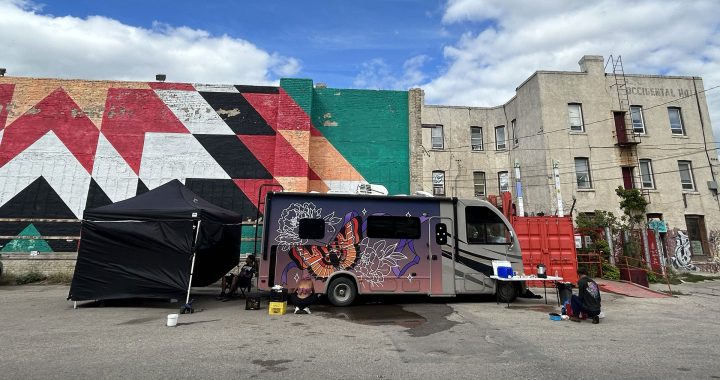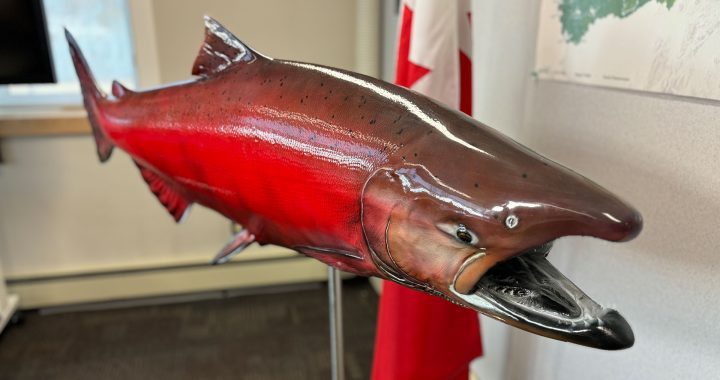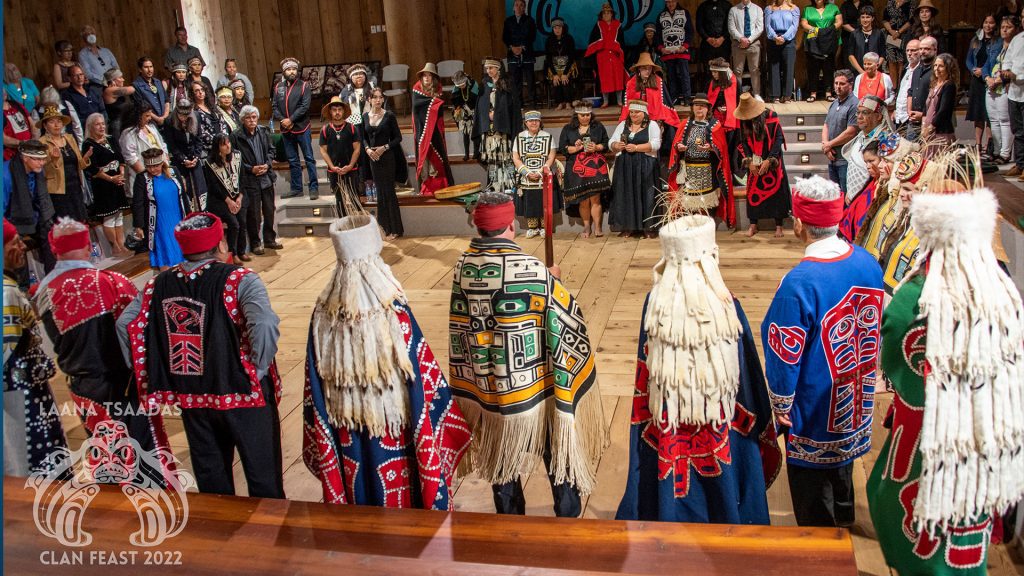
Both families face each other inside the house, for the next proceedings. Photo: Byrds Eye View Photography-Roberta Aiken
After sleeping for 150 years, the Haida clan of Laana Tsaadas is awakening.
Building on careful research and closely-kept teachings, Laana Tsaadas is celebrating the first mask dance in five generations that marked the return of ceremonies once made illegal under colonial policies.
Kalga Jaad (Erin Brillon) has carried the duties of her clan like a seed inside her. In Haida culture, key positions like chiefs and matriarchs are passed down through the mother’s line — and holding those positions is typically a responsibility of the eldest child of the lineage.
As the eldest daughter of her generation, Kalga Jaad always felt a sense of responsibility, but had to search for what that meant. She and her brother Skil Xaaw (Jesse Brillon) grew up “obsessed with culture,” she says, driven by a deep sense of knowing.
“Every time we were around it, we’d wonder: why don’t we know more?” Kalga Jaad explains.
“My clan was essentially dormant for over five generations because we were by law not allowed to practice our culture.”
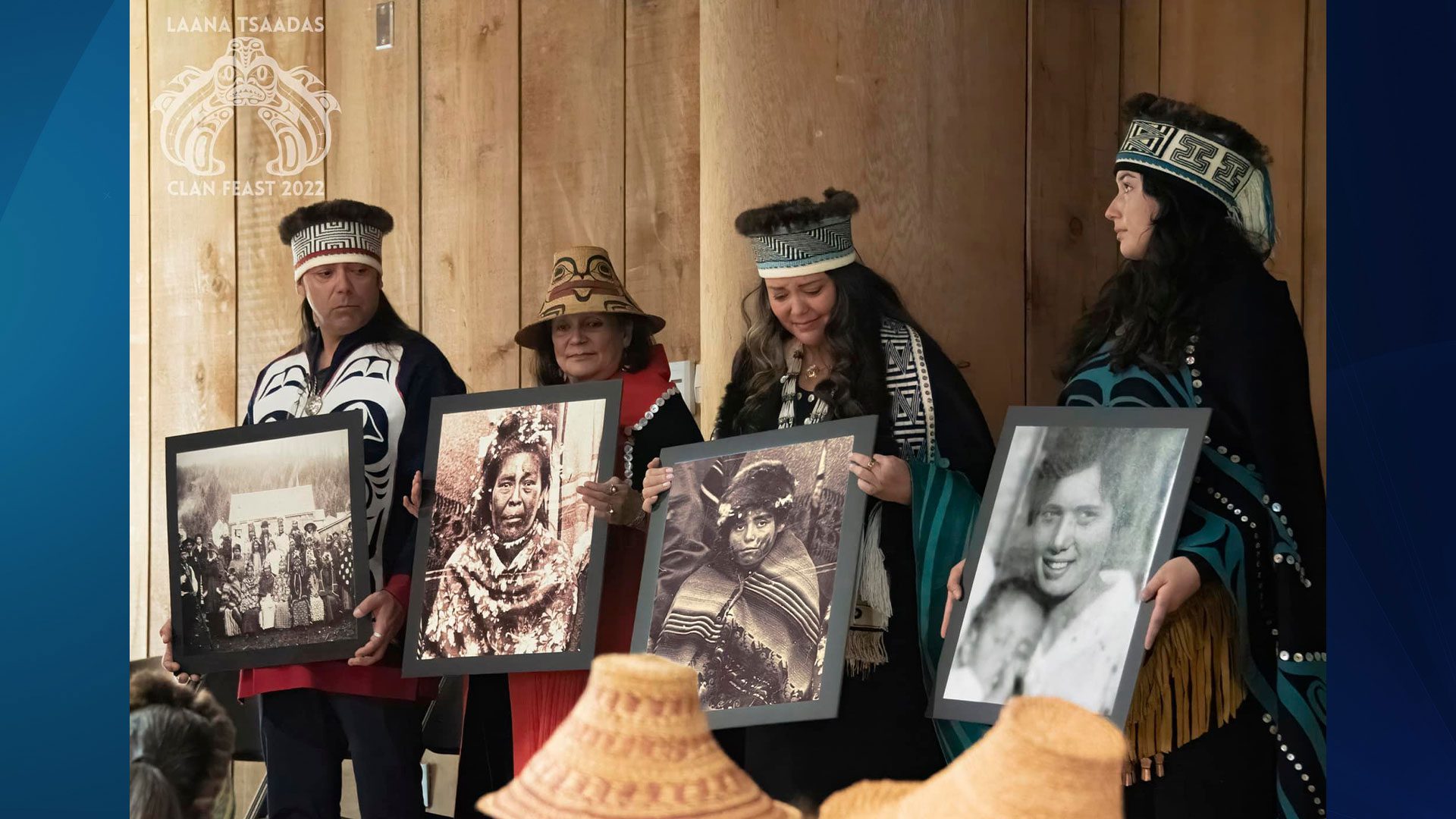
Unsung songs and buried dances
The clan’s dormancy is connected to the Canadian government’s Potlatch Ban that that was in place between 1885 and 1951. It criminalized all Indigenous ceremonies as part of a colonial effort to erase Indigenous cultures, economies and people.
Kalga Jaad has a historic photo of Haidas from her home village of HlG̲aagilda (Skidegate), taken in the late 1800s by a Christian missionary. In the photo, the women are wearing ceremonial regalia — the last record before the items were confiscated, she says, and later sold to collectors and museums.
“That was basically the last time they were allowed to wear any of their cultural regalia,” Kalga Jaad says.
Two of Kalga Jaad’s matrilineal relations are among those women. Not only was their regalia taken, but totem poles were cut down, stripped out of the villages, and also sold.
“There’s this massive loss of culture because [the ban] was imposed by the Canadian government and enforced by the churches. And soon after, children were being taken away to residential schools,” she says.
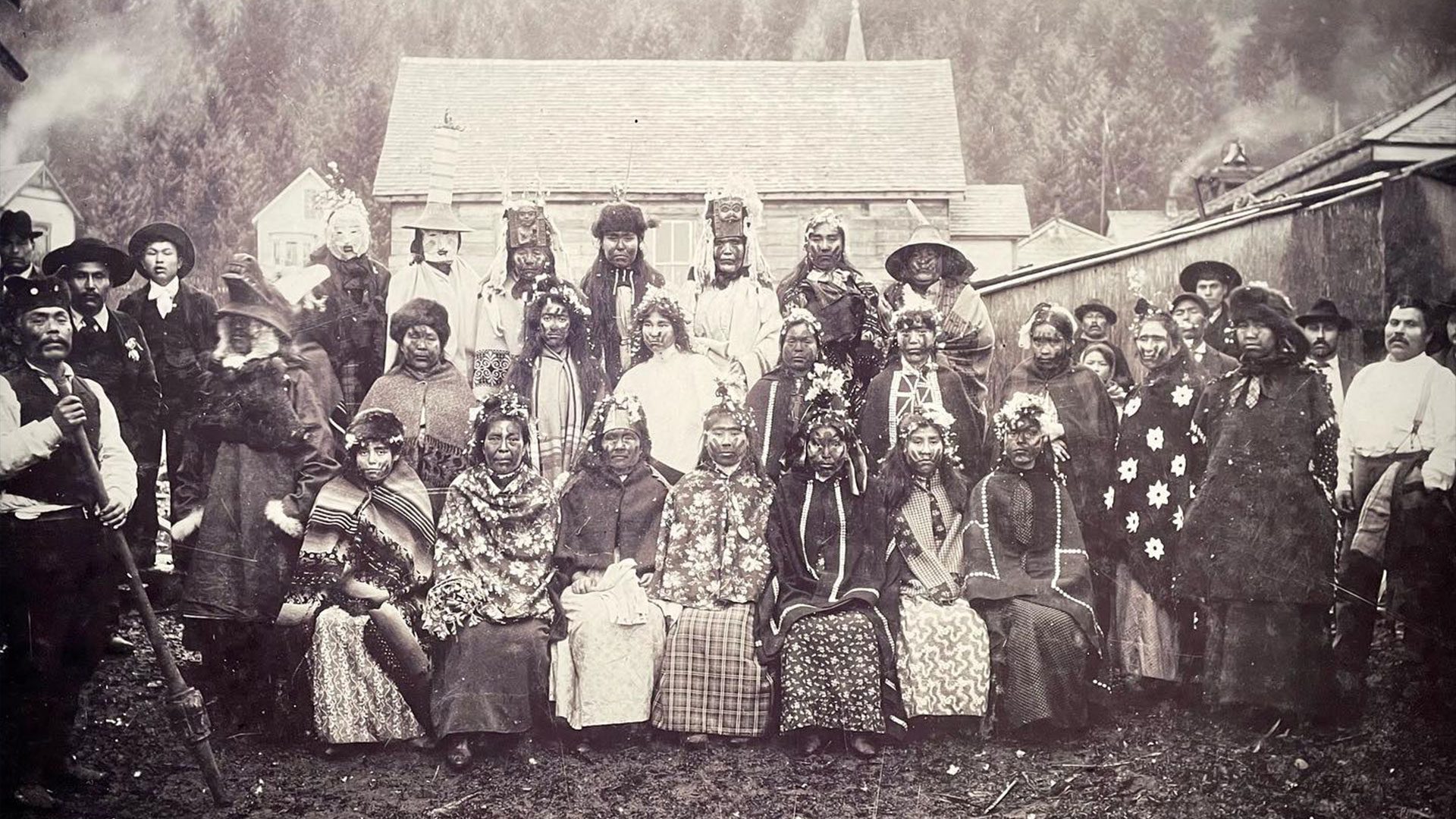
Although the effects of colonization are devastating — the culture was never erased. Kalga Jaad and her brother Skil Xaaw grew up in Vancouver attending urban Haida feasts where they learned songs and dances brought back by Robert and Reg Davidson.
“Through them and other culture keepers, we were able to start re-engaging with the culture from a fairly young age,” she says.
“This is not something that we’ve consciously done, but unconsciously, I feel like we have understood the responsibility that lies on the eldest,” Kalga Jaad says. Her brother Skil Xaaw is also the eldest son.
“As I understood more about our culture, I recognized that we were doing what would’ve been expected of us traditionally.”
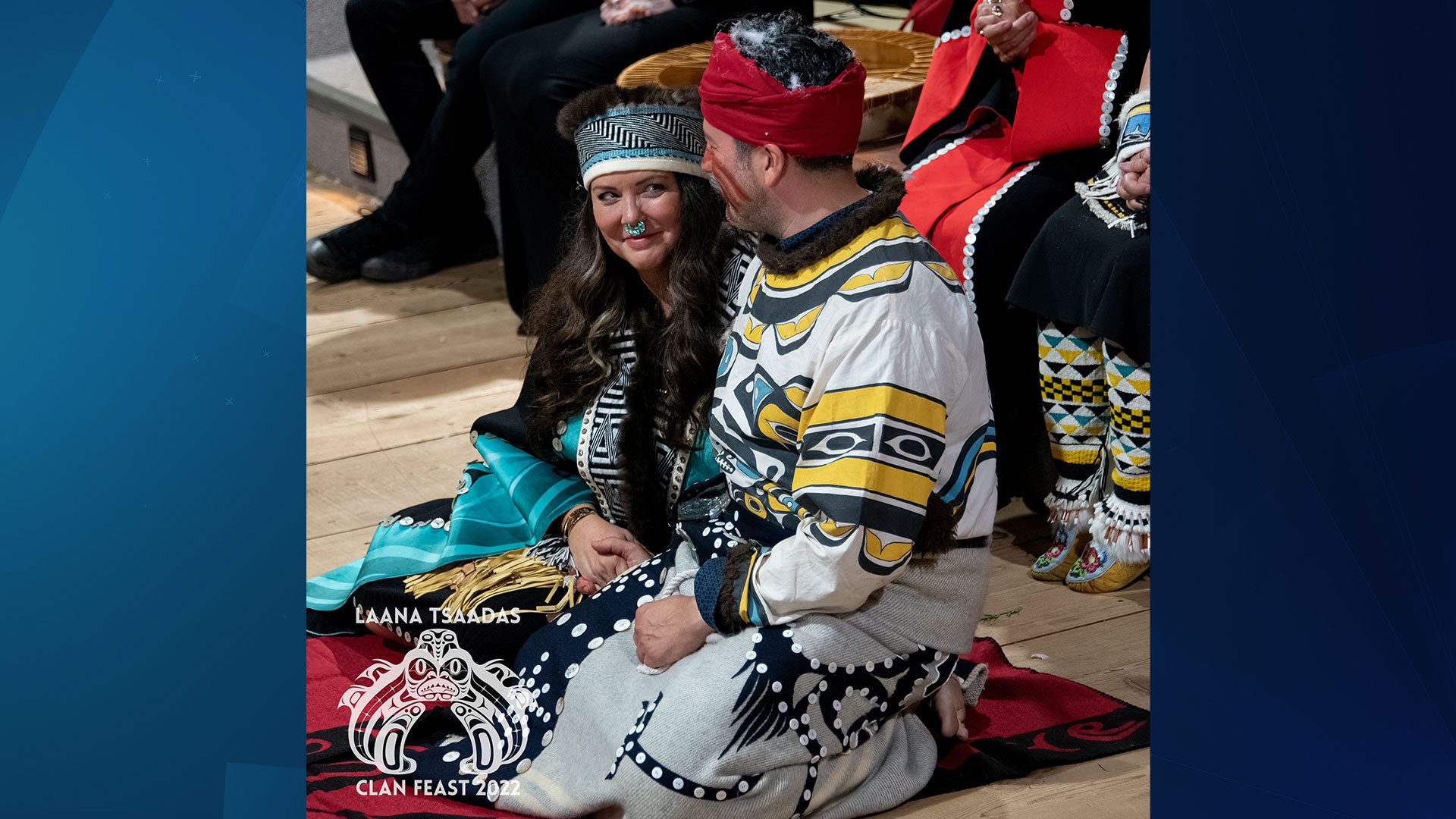
An act of love, family and community
The mask dance and feast is now an historic event that took place in Haida Gwaii on June 25 — marking the return of Laana Tsaadas. Working together, artists, dancers, and singers carefully crafted new masks and regalia.
Skil Xaaw designed the dance screen, which is now among other cultural objects made for their Clan feast that is on display at The Haida Museum until Dec. 24 . Kalga Jaad worked at timing the feast to match his opening.
The need for healing within communities was expressed at the feast by Chief Wigaanad, whose father David Crosby was of Laana Tsaadas clan.
Kalga Jaad says the chief stood up at the feast and said, “We have to stand together because we’re stronger together.”
She says “it opened everyone’s hearts and the trueness of the words that we have to put the negativity aside. If we just put those things aside and step forward and step into our hearts, it really does start to transform the community.”
Everyone there witnessed the power of the words, she adds, and “there was not a dry eye in the house.”
Chief Wigaanad gifted the clan a copper, a form of currency in potlatches.
“Coppers are still used in potlatches nowadays, in a different capacity than what they traditionally were used for,” Kalga Jaad explains.

Careful reconstruction
Thirty years of careful research by Kalga Jaad’s uncle, Ken Brillon, built the foundation for this revitalization — one he sadly did not get to witness because he recently passed away. Ken started with the oral histories and then tried to substantiate them with any written record.
“He had a massive library, the most extensive library of Haida cultural books,” she says. Helping with Brillon’s research was Andy Everson, with an academic background in anthropology.
It wasn’t easy.
Everson says Laana Tsaadas is a smaller clan that didn’t capture the attention of western anthropologists.
“Anytime there’s ethnographic work, it’s always slanted towards whoever the informants are, and it’s always biased,” Everson says. “And because their clan was so small, it was relegated to literally a handful of passages, almost footnotes.”
He speaks from the experience of his own family, with an abundance of documentation and archival material. His great, great-grandfather worked with Franz Boas for 30 years, and his family benefits to this day from the results.
“Being able to scour volumes of information,” he explains, “and then going and looking at Erin’s clan where it’s just kind of pushed to the periphery of the historical records. It’s like a night and day contrast.”

Now that the clan is officially revived through the ceremony, the people gathered did the work that a clan typically would: officiating a traditional marriage.
Kalga Jaad’s husband, Andy Everson, who is Kwakwaka’wakw, visited his bride’s village as a step in the traditional marriage process — bringing four of his chiefs to meet with her family.
Skil Xaaw created a copper that was gifted to the groom’s family during the wedding ceremony. He also made a chief’s frontlet of copper and inlaid abalone, which was added to a headdress Kalga Jaad made of ermine, abalone, and sea lion whiskers. Wearing this regalia, he danced with the groom to show unity.
Kalga Jaad’s eldest daughter, Marlo Brillon, was mentored by her artist uncle Skil Xaaw, and carved and painted a dogfish mask.
Dogfish is one of the primary crests of their clan, also shared among other Haida clans. Marlo received her Haida name at the same feast — Xaayling’tso means “bright sunbeam that breaks through storm clouds.”
Dancing with her mask, Xaayling’tso was a bright sunbeam, breaking through 150 years of oppression— Laana Tsaadas has returned.
Editor’s note: IndigiNews has purposefully used watermarked versions of photos submitted for this story — Kalga Jaad and her family added the marks indicating the clan feast to ensure the context behind the images remained intact.





